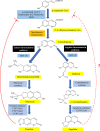Angelicin-A Furocoumarin Compound With Vast Biological Potential
- PMID: 32372949
- PMCID: PMC7176996
- DOI: 10.3389/fphar.2020.00366
Angelicin-A Furocoumarin Compound With Vast Biological Potential
Abstract
Angelicin, a member of the furocoumarin group, is related to psoralen which is well known for its effectiveness in phototherapy. The furocoumarins as a group have been studied since the 1950s but only recently has angelicin begun to come into its own as the subject of several biological studies. Angelicin has demonstrated anti-cancer properties against multiple cell lines, exerting effects via both the intrinsic and extrinsic apoptotic pathways, and also demonstrated an ability to inhibit tubulin polymerization to a higher degree than psoralen. Besides that, angelicin too demonstrated anti-inflammatory activity in inflammatory-related respiratory and neurodegenerative ailments via the activation of NF-κB pathway. Angelicin also showed pro-osteogenesis and pro-chondrogenic effects on osteoblasts and pre-chondrocytes respectively. The elevated expression of pro-osteogenic and chondrogenic markers and activation of TGF-β/BMP, Wnt/β-catenin pathway confirms the positive effect of angelicin bone remodeling. Angelicin also increased the expression of estrogen receptor alpha (ERα) in osteogenesis. Other bioactivities, such as anti-viral and erythroid differentiating properties of angelicin, were also reported by several researchers with the latter even displaying an even greater aptitude as compared to the commonly prescribed drug, hydroxyurea, which is currently on the market. Apart from that, recently, a new application for angelicin against periodontitis had been studied, where reduction of bone loss was indirectly caused by its anti-microbial properties. All in all, angelicin appears to be a promising compound for further studies especially on its mechanism and application in therapies for a multitude of common and debilitating ailments such as sickle cell anaemia, osteoporosis, cancer, and neurodegeneration. Future research on the drug delivery of angelicin in cancer, inflammation and erythroid differentiation models would aid in improving the bioproperties of angelicin and efficacy of delivery to the targeted site. More in-depth studies of angelicin on bone remodeling, the pro-osteogenic effect of angelicin in various bone disease models and the anti-viral implications of angelicin in periodontitis should be researched. Finally, studies on the binding of angelicin toward regulatory genes, transcription factors, and receptors can be done through experimental research supplemented with molecular docking and molecular dynamics simulation.
Keywords: angelicin; biological activities; biological potential; furocoumarin; psolaren.
Copyright © 2020 Mahendra, Tan, Lee, Yap, Pusparajah, Low, Tang, Chan, Lee and Goh.
Figures








Similar articles
-
New Application of Psoralen and Angelicin on Periodontitis With Anti-bacterial, Anti-inflammatory, and Osteogenesis Effects.Front Cell Infect Microbiol. 2018 Jun 5;8:178. doi: 10.3389/fcimb.2018.00178. eCollection 2018. Front Cell Infect Microbiol. 2018. PMID: 29922598 Free PMC article.
-
ERα and Wnt/β‑catenin signaling pathways are involved in angelicin‑dependent promotion of osteogenesis.Mol Med Rep. 2019 May;19(5):3469-3476. doi: 10.3892/mmr.2019.9999. Epub 2019 Mar 1. Mol Med Rep. 2019. PMID: 30864714 Free PMC article.
-
Angelicin regulates LPS-induced inflammation via inhibiting MAPK/NF-κB pathways.J Surg Res. 2013 Nov;185(1):300-9. doi: 10.1016/j.jss.2013.05.083. Epub 2013 Jun 19. J Surg Res. 2013. PMID: 23816246
-
Psoralen: A Biologically Important Coumarin with Emerging Applications.Mini Rev Med Chem. 2020;20(18):1838-1845. doi: 10.2174/1389557520666200429101053. Mini Rev Med Chem. 2020. PMID: 32348216 Review.
-
Nell-1 Is a Key Functional Modulator in Osteochondrogenesis and Beyond.J Dent Res. 2019 Dec;98(13):1458-1468. doi: 10.1177/0022034519882000. Epub 2019 Oct 14. J Dent Res. 2019. PMID: 31610747 Free PMC article. Review.
Cited by
-
Angelicin Alleviates Maternal Isoflurane Exposure-Induced Offspring Cognitive Defects Through the Carbonic Anhydrase 4/Aquaporin-4 Pathway.Mol Biotechnol. 2024 Jan;66(1):34-43. doi: 10.1007/s12033-023-00723-0. Epub 2023 Mar 30. Mol Biotechnol. 2024. PMID: 36997697
-
Isopimpinellin inhibits UVA-induced overproduction of MMPs via suppression of MAPK/AP-1 signaling in human dermal fibroblasts.Food Sci Biotechnol. 2024 Jul 24;33(15):3579-3589. doi: 10.1007/s10068-024-01611-2. eCollection 2024 Dec. Food Sci Biotechnol. 2024. PMID: 39493386
-
Intestinal biofilms: pathophysiological relevance, host defense, and therapeutic opportunities.Clin Microbiol Rev. 2024 Sep 12;37(3):e0013323. doi: 10.1128/cmr.00133-23. Epub 2024 Jul 12. Clin Microbiol Rev. 2024. PMID: 38995034 Review.
-
Targeting Gut Microbial Biofilms-A Key to Hinder Colon Carcinogenesis?Cancers (Basel). 2020 Aug 13;12(8):2272. doi: 10.3390/cancers12082272. Cancers (Basel). 2020. PMID: 32823729 Free PMC article. Review.
-
Phytochemicals for the Prevention and Treatment of Renal Cell Carcinoma: Preclinical and Clinical Evidence and Molecular Mechanisms.Cancers (Basel). 2022 Jul 4;14(13):3278. doi: 10.3390/cancers14133278. Cancers (Basel). 2022. PMID: 35805049 Free PMC article. Review.
References
Publication types
LinkOut - more resources
Full Text Sources

